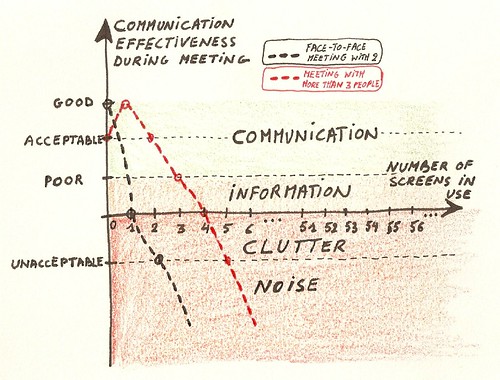Screens exert an enormous gravitational power that pulls the effectiveness of a communication downward. Being aware of this power will make us use these screens more consciously.
Last week I underscored the distinction between communication and non-communication. The bottom line is that you should always ask yourself whether your action is being in service of ‘community’ or not. If the answer is yes, then you are practicing the art of communication.
Are we on the same Screen?
In this article I want to reflect on what this means in terms of the optimal number of screens that should be in use during a meeting; this includes all kinds of screens: laptops, desktops, large presentation screens, smartphones, tablets and e-readers.
Remember that meeting where the chairman is pointing to the screen, your neighbors are fiddling around on their iPad, and you are checking your email on your Blackberry? Sure, you heard what was being said and the exchange of information did not get lost. But was it worth having a meeting for? Could the same information not be exchanged by email?
The point is that a screen – no matter how small – exerts gravitational power on the attention of human beings in its proximity. This is not positive or negative. It’s just a fact we need to be aware of. Once we are fully aware of the gravitational power of a screen, we can start using it consciously when we chair a meeting and when we are in a conversation.
The above graph summarizes what it all comes down to. The different types of communication are visible as layers. The number of screens in use during a meeting determine the effectiveness of the communication. Let’s have a look at what this means for a face-to-face communication between to people (black dotted line) and for a meeting with more than five people (red dotted line).
The gravitational power of screens and the damage it does to communication is clearly visible on this graph. For a face-to-face conversation, zero screens is best for communication (i.e.: conversation and relationship) to happen. For a meeting where more people are present, a screen may come in handy to make sure all people are on the same page / screen.
The Moral
A few years ago, answering your phone or checking your email used to be rude. Now it is the norm. Again, this is fine when you want to exchange information, but for true conversation or relationship to occur, I advise to drop the device.
As for meetings, the advice is to have less meetings, and to be there with our full consciousness whenever a meeting is organized. I bet those meetings will be better prepared, will not take so long and create better community. Strange as it may seem, a device-less meeting sounds like a revolutionary thing.


